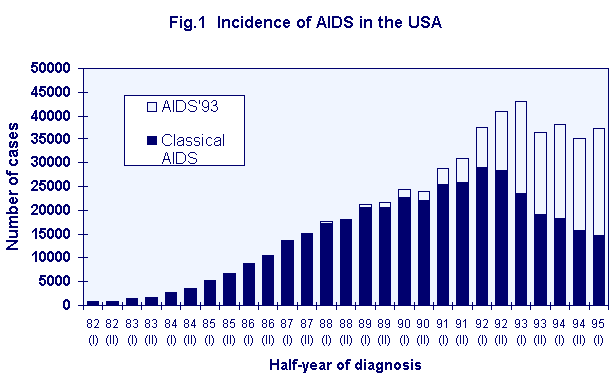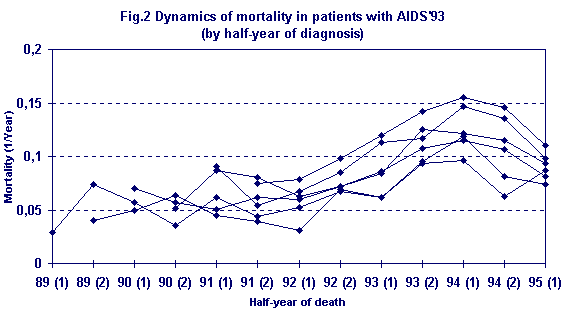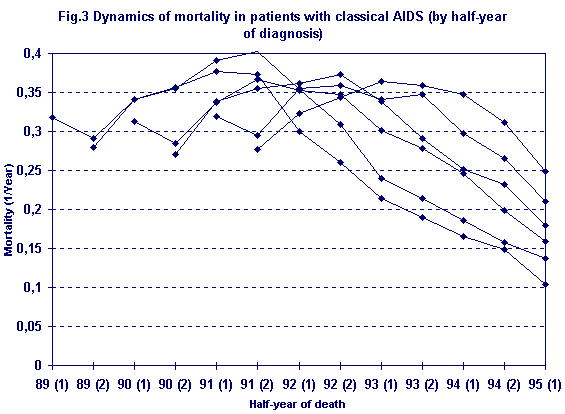SOME FACTS BEHIND THE EXPANSION OF THE DEFINITION OF AIDS IN 1993 By Vladimir L. Koliadin
March 1998
Epidemic of AIDS in the USA has been declining steadily since 1992, but this fact has been concealed by expansion of the definition of AIDS in 1993. Implementation of the new definition artificially boosted the number of AIDS cases reported in the national AIDS statistics at least 2-2.5 times. In 1993, medical status of about 36,000 asymptomatic HIV-positive Americans was changed on purely formal basis - they became "AIDS-patients" only because the new definition of AIDS was implemented by the CDC. This formal change of diagnosis coincides in time with conspicuous increase in mortality. This fact is in agreement with the unorthodox hypotheses that AIDS- specific medication makes more harm than good and that AIDS is as an iatrogenic (caused by medicine) disease.1. The new (1993) definition of AIDS
In December 1992 CDC published a new expanded surveillance definition of AIDS [1]. According to the CDC, "this expansion includes all HIV-infected adults and adolescents who have less than 200 CD4+ T-lymphocytes/microlitre or a CD4+ T-lymphocyte percent of total lymphocytes less than 14, or who have been diagnosed with pulmonary tuberculosis, invasive cervical cancer, or recurrent pneumonia" [2, p.9]. Thus, the new definition is based mainly on results of laboratory tests Ė positive test for HIV-antibodies and low enough T4-cell count. I n contrast to earlier definitions of AIDS, opportunistic infections are not necessary for diagnosis of AIDS. Any HIV-seropositive individual with low counts of T4-lymphocytes since 1993 is being considered as "AIDS-patient".
In this paper, the cases which meet only the new 1993-definition of AIDS will be named AIDSí93; the cases which meet earlier (1987, 1985, or pre1985) definitions will be named "classical AIDS". If the definition of AIDS had not been expanded in 1993, only the cases of "classical AIDS" would be considered as AIDS and accounted for in national AIDS statistics.
Naturally, the expansion of the definition of AIDS had to increase the number of AIDS cases on purely formal basis of reclassification. To avoid such a conspicuous upward "step" in the reported trends of incidence of AIDS, the CDC included in AIDS statistics cases of AIDSí93 diagnosed retrospectively. The date of diagnosis for these cases precedes January 1993. This date was established from information on HIV-status and CD4-counts (or presence of TB, recurrent pneumonia, or invasive cervical cancer) from medical records.
2. AIDSí93 is far less severe than classical AIDS
It is natural to expect that cases of AIDSí93 have much lower mortality rate than cases of the classical AIDS. To establish the difference, probability to die in 2-year period after diagnosis have been calculated from the CDCís database [2] separately for classical AIDS and AIDSí93. Then, the probabilities were converted to the odds - that is, to ratios between the probability to have died and the probability to survive (in 2 years after diagnosis of AIDS). If P is probability to have died, the odds "to die" against "to survive" are computed as P/(1-P). The results are presented in Table 1 for different years of diagnosis.
Table 1. Probabilities (P) to die within 2 years after diagnosis, the odds "to die" against "to survive", and the odds ratios (by year of diagnosis)
Classical AIDS
AIDS'93
Year of diagnosis
P
Odds: P/(1-P)
P
Odds: P/(1-P)
Odds ratio
1988
0.60
1.47
0.11
0.12
11.89
1989
0.57
1.35
0.10
0.11
12.02
1990
0.56
1.29
0.13
0.15
8.69
1991
0.56
1.28
0.18
0.22
5.95
1992
0.55
1.23
0.25
0.33
3.75
1993
0.54
1.19
0.26
0.36
3.35
It is obvious from the table that classical AIDS and AIDSí93 differ dramatically in severity (as judged by mortality). For the cases with the date of diagnosis 1988-1990, probabilities to die within 2 years after diagnosis were 4-6 times smaller for the cases of AIDSí93 as compared to cases of classical AIDS; the odds "to die" against "to survive" were 8-12 times as small. During 1990-1992, the 2-year death rate in AIDSí93 group increased about 2.5 times - roughly from 0.1 in 1988-89 to 0.25 in 1992-93. Because of this growth, the ratio between the odds for classical AIDS and AIDSí93 reduced from 12 (in 1988-89) to about 3.5 (in 1992-93). The nature of this trend will be considered later. Here, it is important just to note that AIDSí93 is characterized by much lower mortality than classical AIDS: the odds "to die" against "to survive" in 2 years after diagnosis are 3.5-12 times higher for classical AIDS than for AIDSí93.
Because of this difference, it is reasonable to present statistics of incidence separately for the two types of AIDS cases. Nevertheless, the numbers on both types are usually presented together in the national AIDS statistics as well as in other publications. Naturally, such combining of classical AIDS and AIDSí93 disguises some important features of the actual dynamics of the epidemic of AIDS in the USA. The goal of further consideration is to reveal the peculiarities of trends in incidence of AIDS which cannot be noticed from the combined statistics.
3. Epidemic of classical AIDS has been declining rapidly since 1992
How would the dynamics of AIDS incidence look like if the definition of AIDS had not been expanded in 1993? To answer this question it is enough to look at the dynamics of incidence for classical AIDS alone. The CDCís database [2] has been used as the source of the primary data. The numbers of cases were adjusted for delay in case and death reporting in accord with the coefficients provided by the CDC in database the [2].Incidence of classical AIDS and AIDSí93 is presented separately on Fig.1. (Height of black bars corresponds to the number of cases of classical AIDS registered in a given half-year period; height of white bars - to the number of AIDSí93 cases).
It is obvious from Fig.1 that the epidemic of AIDS in the USA (as judged by the incidence of classical AIDS) has been declining steadily since 1992. The maximal number of new cases were registered in the first half of 1992 (29,016 cases). Three years later, in the first half of 1995, the incidence was 2 times as low (14,758 cases). This trend is not noticeable from the combined statistics (total height of the bars on Fig.1). This disguising effect is due to inclusion of the cases of AIDSí93. Even in the first half of 1993 cases of the classical AIDS constituted only 55 percent of all cases reported; in the first half 1995 - only 40 percent. Thus, implementation of the new definition of AIDS changed the national AIDS statistics in two respects: it boosted the number of cases at least 2-2.5 times, and concealed the downward trend in incidence of AIDS.
4. AIDS-diagnosis itself increases mortality (iatrogenic effect of AIDS-specific medication)
About 36,000 of HIV-positive Americans (most of whom had no any diseases) in 1993 were reclassified retrospectively into " AIDS-patients" on the purely formal basis - only because definition of AIDS was expanded. These individuals had been living for some time with AIDSí93 but were not considered as "AIDS-patients" at least till late 1992. How did this formal diagnosis of AIDS affect their health? Such a change in diagnosis resulted in administration of additional medication, at least in some proportion of these individuals. If such AIDS-specific medication improves health (as it is widely believed), mortality had to decrease. On the other hand, if the medication is harmful (as some independent AIDS-researchers believe), mortality have to increase. The goal of the following consideration is to establish which view is closer to the truth.
While analyzing death rates in 2-year period after diagnosis (see Table 1 and section 2) it was noted that the death rates increased for cases of AIDSí93 in 1991-1993 for some reasons. This suggests that some increase in mortality took place for cases of AIDSí93 after 1991. To investigate this effect in details, dynamics of mortality has been analyzed for cases of AIDSí93 for each half-year period following the date of diagnosis.. The CDCís database [2] was used as the source of primary data. The cases of AIDSí93 with the date of diagnosis in 1989-1991 were subdivided into 6 groups by half-year of diagnosis. Then, for each group, mortality has been calculated for each half-year period since the half-year of diagnosis to the first half-year of 1995. The half-year mortality rates were estimated as the number of death occurred within the half-year period divided by the number of individuals who were alive in the very beginning of the period. The rates were adjusted to one-year interval. The results are presented on Fig.2. Each curve reflects dynamics of mortality for cases of AIDSí93 diagnosed in the same half-year period. The most left point of each curve corresponds to the half-year of diagnosis of the group.
As far as data in the CDCís database [2] are more or less reliable, the following conclusions may be drawn from Fig.2. Mortality rates in all the 6 groups of AIDSí93 patients began to grow since the second half of 1992. By 1994 the increase was about 2-fold as compared to the pre-1993 level. It is important to note that the increase in mortality is associated with calendar time itself, not with the time elapsed since the date of diagnosis. This strongly suggests that the growth of mortality was caused not by natural course of the disease, but by some external factors which started to exert their influence since the second half of 1992 and affected the individuals with AIDSí93 irrespective to the date of diagnosis.
Were patients with classical AIDS also influenced by these mortality-increasing factors? To answer the question, dynamics of mortality was calculated for patients with classical AIDS in the same way as for AIDSí93. The results are presented on Fig.3. In this group, there is no any noticeable increase in mortality associated with the calendar time itself. Dynamics of mortality depends mainly on the time elapsed since the date of diagnosis (the curves for later half-year of diagnosis are about the same shape but shifted rightwards).
What are the factors which began to affect the AIDSí93 patients in the second half of 1992 (but not patients with classical AIDS)? Just in the second half of 1992 the diagnostic tendency became prominent in the USA to consider low counts of T4-cells in asymptomatic HIV-positives as AIDS. This tendency was officially adopted by the CDC in December 1992 [1]. The individuals whose mortality rates are presented on Fig.2 had been living with AIDSí93 (but without AIDS-diagnosis) from 1 to 4 years. Only since late 1992 their condition began to be considered as AIDS. Just that time mortality in these individuals began to grow. Thus, the purely formal reclassification of these individuals from "asymptomatic HIV-positives" into "AIDS-patients" coincides in time with a noticeable increase in mortality. A reasonable explanation for this phenomenon is that just the additional AIDS-specific medication administered to some of these individuals (because of their formal reclassification into "AIDS-patients") caused this increase in mortality. Thus, the CDCís data are in perfect agreement with predictions of the unorthodox iatrogenic hypotheses, which imply that AIDS-specific medication makes more harm than good.
There is another interesting peculiarity noticeable in data on Fig.2. Mortality for cases of AIDSí93 reached higher levels for the cases with later date-of-diagnosis. For example, for the individuals with the date of diagnosis in 1989 maximal mortality (probability of death) was about 0.1 per year in 1994; for the individuals with the date-of-diagnosis in 1991 was abou 0.15/year or about 1.5 times higher. In other words, the individuals who had been living with AIDSí93 (but without AIDS-diagnosis) longer, were affected by the formal change of their medical status to a less extent. This peculiarity in mortality trends has a natural explanation within the framework of the iatrogenic hypotheses: those who had been living with AIDSí93 but without health problems for, say, 4 years are less prone to accept additional (AIDS-specific) medication only because the formal change of their diagnosis as compared to those who had been living with AIDSí93 only, say, a year.
5. Why the definition of AIDS was expanded just in late 1992
It is easy to note from Fig.1 that maximal incidence of classical AIDS in the USA was reached in the first half of 1992; then the number of new cases has been declining steadily. Was it a purely random coincidence in time that the CDC expanded the definition of AIDS just in late 1992? If public and policy makers would have realized that epidemic of AIDS is declining, this might have resulted in reduction of budget for AIDS research and prevention programs, including the budget of the CDC themselves. Expansion of the definition of AIDS in 1993 helped to disguise the downward trend in epidemic of AIDS (see Fig.1 and section 3). It is reasonable to suppose that an essential motif behind the implementation of the new definition of AIDS just in 1993 was strong unwillingness of the CDC to reveal the declining trend of AIDS epidemic.
References
[1] Centers for Disease Control. Morbidity and Mortality Weekly Report, Recommendations and Reports, December 18, 1992
[2] Centers for Disease Control. AIDS Public Information Data Set. Data through December 1995 (6 disks + 51 pages manual)


